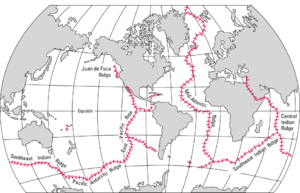Pacific-Antarctic Ridge

The Pacific-Antarctic Ridge (PAR) is a divergent tectonic plate boundary located on the seafloor of the South Pacific Ocean, separating the Pacific Plate from the Antarctic Plate. It is regarded as the southern section of the East Pacific Rise in some usages, generally south of the Challenger Fracture Zone and stretching to the Macquarie Triple Junction south of New Zealand.[1]
The Louisville seamount chain

Stretching for 4,300 km north-west from the Pacific-Antarctic Ridge to the Osbourn Seamount at Tonga and Kermadec Junction[2] is a long line of seamounts called the Louisville seamount chain - the longest such chain in the Pacific[3] - thought to have formed from the Pacific Plate sliding over a long-lived center of upwelling magma called the Louisville hotspot. The Louisville hotspot takes its name from its discoverer, George Louis, a well-known geologist.
See also
References
- ↑ "Pacific-Antarctic Ridge". www.britannica.com. Retrieved 5 April 2013.
- ↑ Keating, Barbara H. (1987). Seamounts, Islands, and Atolls. American Geophysical Union. ISBN 0-87590-068-2.
- ↑ "Isotopic evidence for a hotspot origin of the Louisville Seamount Chain". www.agu.org. Retrieved 5 April 2013.
Further reading
- Cande, S. C., Raymond, C. A., Stock, J., & Haxby, W. F. (1995). "Geophysics of the Pitman Fracture Zone and Pacific-Antarctic plate motions during the Cenozoic". Science. 270 (5238): 947–953. Bibcode:1995Sci...270..947C. doi:10.1126/science.270.5238.947.
Coordinates: 61°59′58″S 157°00′01″W / 61.999555°S 157.000165°W
